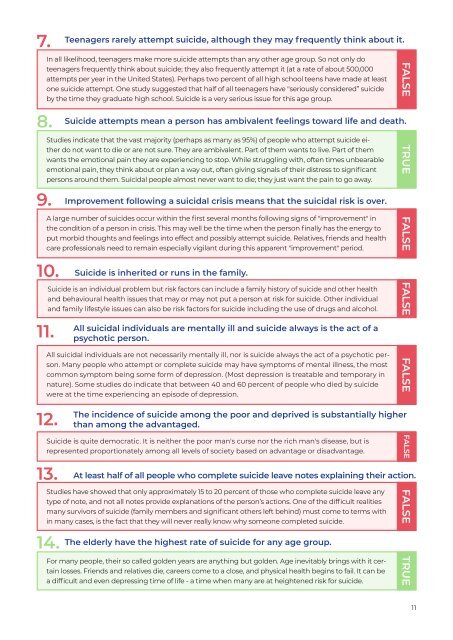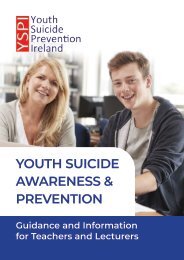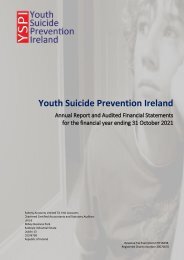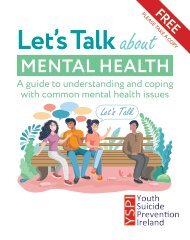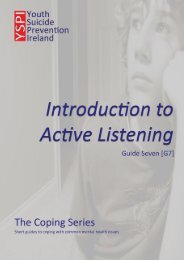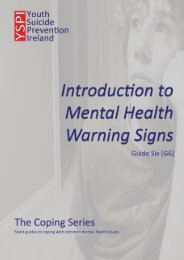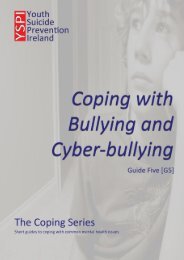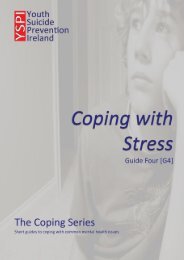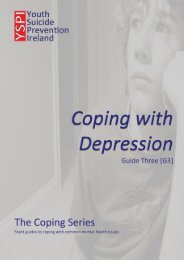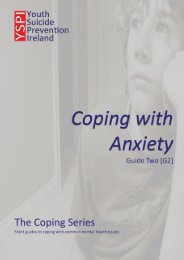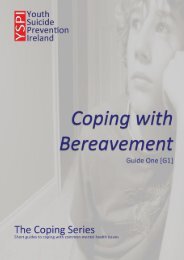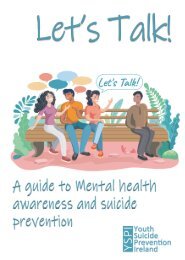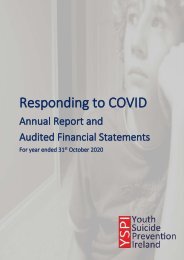What are they thinking? - YSPI Parents Handbook
A Parents Handbook to youth mental health and suicide prevention, now in it's 10th edition. Topics covered include: * Introduction to youth mental health awareness * Awareness of mental health risk factors * Recognising the symptoms of mental health issues * Helping someone with mental health issues * Understanding the dangers: Cyber-bullying Online Dangers Locked-away Syndrome * Supporting and developing coping strategies * Warnings signs of suicidal thoughts * Suicide Prevention and intervention * How to help and get help
A Parents Handbook to youth mental health and suicide prevention, now in it's 10th edition.
Topics covered include:
* Introduction to youth mental health awareness
* Awareness of mental health risk factors
* Recognising the symptoms of mental health issues
* Helping someone with mental health issues
* Understanding the dangers:
Cyber-bullying
Online Dangers
Locked-away Syndrome
* Supporting and developing coping strategies
* Warnings signs of suicidal thoughts
* Suicide Prevention and intervention
* How to help and get help
You also want an ePaper? Increase the reach of your titles
YUMPU automatically turns print PDFs into web optimized ePapers that Google loves.
7.<br />
8.<br />
9.<br />
10.<br />
11.<br />
12.<br />
13.<br />
14.<br />
Teenagers r<strong>are</strong>ly attempt suicide, although <strong>they</strong> may frequently think about it.<br />
In all likelihood, teenagers make more suicide attempts than any other age group. So not only do<br />
teenagers frequently think about suicide; <strong>they</strong> also frequently attempt it (at a rate of about 500,000<br />
attempts per year in the United States). Perhaps two percent of all high school teens have made at least<br />
one suicide attempt. One study suggested that half of all teenagers have "seriously considered” suicide<br />
by the time <strong>they</strong> graduate high school. Suicide is a very serious issue for this age group.<br />
Suicide attempts mean a person has ambivalent feelings toward life and death.<br />
Studies indicate that the vast majority (perhaps as many as 95%) of people who attempt suicide either<br />
do not want to die or <strong>are</strong> not sure. They <strong>are</strong> ambivalent. Part of them wants to live. Part of them<br />
wants the emotional pain <strong>they</strong> <strong>are</strong> experiencing to stop. While struggling with, often times unbearable<br />
emotional pain, <strong>they</strong> think about or plan a way out, often giving signals of their distress to significant<br />
persons around them. Suicidal people almost never want to die; <strong>they</strong> just want the pain to go away.<br />
Improvement following a suicidal crisis means that the suicidal risk is over.<br />
A large number of suicides occur within the first several months following signs of "improvement" in<br />
the condition of a person in crisis. This may well be the time when the person finally has the energy to<br />
put morbid thoughts and feelings into effect and possibly attempt suicide. Relatives, friends and health<br />
c<strong>are</strong> professionals need to remain especially vigilant during this app<strong>are</strong>nt "improvement" period.<br />
Suicide is inherited or runs in the family.<br />
Suicide is an individual problem but risk factors can include a family history of suicide and other health<br />
and behavioural health issues that may or may not put a person at risk for suicide. Other individual<br />
and family lifestyle issues can also be risk factors for suicide including the use of drugs and alcohol.<br />
All suicidal individuals <strong>are</strong> mentally ill and suicide always is the act of a<br />
psychotic person.<br />
All suicidal individuals <strong>are</strong> not necessarily mentally ill, nor is suicide always the act of a psychotic person.<br />
Many people who attempt or complete suicide may have symptoms of mental illness, the most<br />
common symptom being some form of depression. (Most depression is treatable and temporary in<br />
nature). Some studies do indicate that between 40 and 60 percent of people who died by suicide<br />
were at the time experiencing an episode of depression.<br />
The incidence of suicide among the poor and deprived is substantially higher<br />
than among the advantaged.<br />
Suicide is quite democratic. It is neither the poor man's curse nor the rich man's disease, but is<br />
represented proportionately among all levels of society based on advantage or disadvantage.<br />
At least half of all people who complete suicide leave notes explaining their action.<br />
Studies have showed that only approximately 15 to 20 percent of those who complete suicide leave any<br />
type of note, and not all notes provide explanations of the person’s actions. One of the difficult realities<br />
many survivors of suicide (family members and significant others left behind) must come to terms with<br />
in many cases, is the fact that <strong>they</strong> will never really know why someone completed suicide.<br />
The elderly have the highest rate of suicide for any age group.<br />
For many people, their so called golden years <strong>are</strong> anything but golden. Age inevitably brings with it certain<br />
losses. Friends and relatives die, c<strong>are</strong>ers come to a close, and physical health begins to fail. It can be<br />
a difficult and even depressing time of life - a time when many <strong>are</strong> at heightened risk for suicide.<br />
FALSE FALSE FALSE FALSE<br />
FALSE FALSE<br />
TRUE TRUE<br />
11


